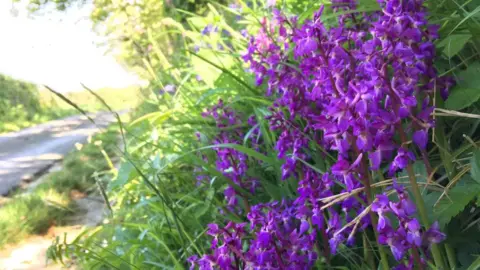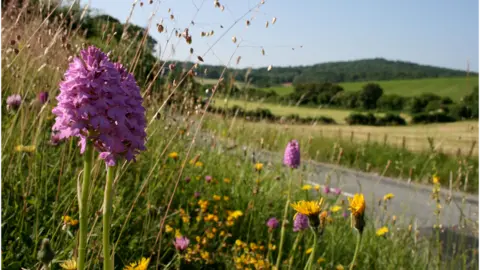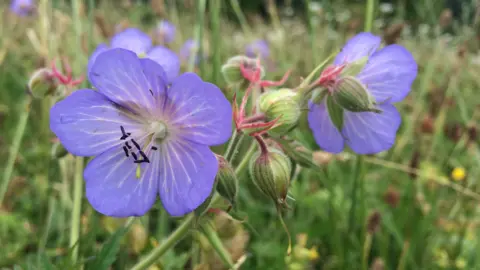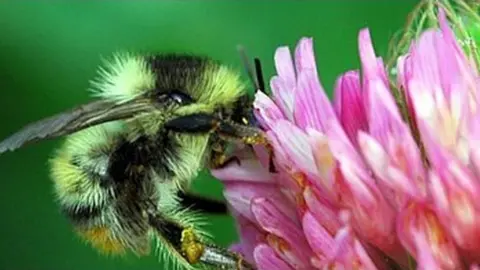Coronavirus: Roadside wildflowers bloom under lockdown
 Trevor Dines
Trevor DinesAfter two months in lockdown, many people are in desperate need of a trim as their hair grows longer and longer.
But for the grass verges sprouting up on Wales' roadsides, the problem faced is quite the opposite.
Campaigners are urging councils not to trim them but let them grow as wild as possible so they can become habitats for species of flowers and bees.
Some local authorities have said they are only cutting verges that affect footpaths or visibility of motorists.
With many council services on hold, has coronavirus given us a glimpse of a world where rare orchids, buttercups, clover and cowslips bloom around us?
Allow X content?

Yes, according to Buglife Cymru's Liam Olds, who said: "Lockdown has demonstrated that, given the opportunity, many of our road verges are flower-rich and have the potential to help address the current 'pollinator crisis' (the lack of habitats for insects such as bees, hoverflies, butterflies and moths).
"It can also bring potential savings (for local authorities) by reducing grass-cutting management of roadside verges, with that staff time being redirected elsewhere."
Mr Olds said more awareness created during the pandemic will help bring nature "into the heart of communities".
 Peter Hatherley
Peter HatherleyIt is an issue some have been aware of for some time, with Peter Hatherley documenting the fate of wildflowers near the M4 in Bridgend.
He described bee orchids being "amazingly" spared when a verge was mown last year, while others by junctions 35 and 36 were "not so lucky".
Plantlife Cymru has campaigned for better protection of these areas since 2013, pointing to a 20% drop in the UK's floral diversity since 1990.
 Plantlife
PlantlifeWith 97% of the country's wildlife meadows also eradicated in the last century, it described grassland roadside verges as crucial habitats and a "safe haven" for 700 species of wildflowers, which make up 45% of all that grow in the UK.
This includes 29 of 52 species of wild orchid, including rarities such as lizard orchid.
It published guidelines last year, intended to be a roadmap for managing 313,500 miles of UK road verges, recommending they should be cut twice a year not four times.
 PlantLife
PlantLifeBotanical specialist Dr Trevor Dines said it was endorsed by the Welsh Government, which manages trunk roads, and it has received "encouraging traction" elsewhere.
"We're also seeing individual councils now taking up the reins too," he said.
"As well as Conwy, both Flintshire and Denbighshire are making positive moves to improve verge maintenance."
Near his Conwy home, he has discovered verges unmown during lockdown that now contain a "stunning population" of early purple orchid and the "very, very rare" purple ramping-fumitory.
Thousands of people have taken to Twitter praising some councils for preserving those that have grown in the past couple of months, and blasting others for cutting them.
Allow X content?

Taking aim at Bridgend council, Rose Revera posted: "Believe it or not, we actually prefer flowers to a short green carpet, as do the bees and butterflies."
The local authority said it has its own highways and parks biodiversity enhancement strategy, commissioned in 2019.
"This means that while we still have to cut at specific locations in order to provide clear lines of sight for drivers or to ensure that footpaths remain accessible, we also maintain hectares of open space in support of wild flowers, and have greatly reduced our annual grass cutting activities," a spokesman said.
He highlighted parts of the A4061 which are not cut, while crews trim around cowslips at Danygraig Hill, and wildflowers have been planted on the cycle route between Brackla and Coity.
Allow X content?

In Cardiff, grass cutting was temporarily suspended at the start of the Covid-19 pandemic, but has now restarted in areas where it is needed for safety reasons.
Cabinet member for culture and leisure Councillor Peter Bradbury said it is focusing on places where it would get "out of hand", such as sports playing surfaces.
He added that verges will only be cut when they affect visibility for motorists and pedestrians.
A spokeswoman for Ceredigion council, which received praise online, said its mowing is always undertaken with a view to "ensuring the safety of road users" while also "adopting a positive approach relating to local environmental stewardship".
Allow X content?

Barnaby Smith, of the Bumblebee Conservation Trust, said the results in spaces previously managed as lawns have been "spectacular", adding there have been anecdotal reports of people appreciating the diversity in communal green spaces more.
However, Mr Smith called for greater understanding among council staff, adding: "Many of the pictures circling on social media are not of native British wildflowers. But why does that matter?
"It can certainly be argued that having something is better than nothing, but it is important that we understand the difference between our natives and non-natives.
"A lack of understanding can lead to a verge full of clover, buttercups, and bird's-foot trefoil, being branded 'untidy' and cut down to make way for Californian poppies, clarkias, and cosmos."
 PA
PAHe said native species have evolved over centuries with pollinators and are the "ideal resource" for them rather than those that have been newly-introduced.
His colleague Sinead Lynch also sounded a word of caution, saying the verges would need to be managed carefully or they would grow into scrub and not be suitable habitats.
However, she believes they could become important sites and also "wildlife corridors" that allow species to roam around Wales, adding: "For bumblebees, isolation of populations can result in inbreeding and eventually local extinctions, which becomes increasingly of concern when it impacts rare and scarce species."
